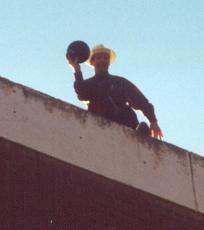
Objective:
1. Determine the height of building using a dropped object.
2. Determine the free fall acceleration (gr) with air resistance using a FBD.
Materials: bowling ball, volleyball, nerf ball, other object, several stop watches
Gravity
and Newton's 2nd Law: The Bowling Ball Drop
Objective:
1.
Determine the
height of building using a dropped object.
2.
Determine
the free fall acceleration (gr) with air resistance
using a FBD.
Materials:
bowling ball, volleyball, nerf ball, other object, several
stop watches
Procedures
1. Sketch the free-body diagram (FBD) of a ball
in free fall. Label
the force of gravity (weight) and the air resistance vectors.
Determine the masses of the three balls.
2. Drop the bowling ball from the height of the
building (teacher does this!). Record the time of free fall with
several stopwatches from the instant of release until impact.
Drop the lowest and highest times, then find the average
of the remaining times.
3. Repeat for a volleyball and for the Nerf Ball.
4. Repeat for another object if available.
Results, Analysis, and
Conclusions
1. Determine the height of the building using the
bowling ball's time as the accepted value.
2. Calculate the velocity and momentum of the
bowling ball upon impact. (p = mv)
3. Using the times for the volleyball and Nerf
ball, calculate the acceleration rate for each.
Now using the free-body diagram and the equilibrium
expression, determine the air resistance for each ball.
What are the units for air resistance?
4. Why did we use the bowling ball's time as the
accepted value for finding the height?
5. Determine the ratio of the volleyball and Nerf
balls' weight/air resistance.
Can you draw any conclusion between this ratio and the
rate of acceleration?
6. If the balls were thrown upward, what would
you predict for the rate of acceleration?
7. Define terminal velocity.
What can you say about the rate of acceleration for an
object that reaches terminal velocity?
Give two examples. Carefully
sketch a FBD showing the forces on an object that has reached
terminal velocity.
8. On the moon, gravity is 1.62 m/s2.
If this entire experiment were performed on the moon, how
much time would it take for the bowling ball to reach the lunar
surface? The
volleyball? The Nerf
Ball? What would be their velocities upon impact?
9. Sketch a FBD of a Nerf ball falling with a
wind out of the west. Show
the approximate resultant force.
Back to the Brockport High School Science Department